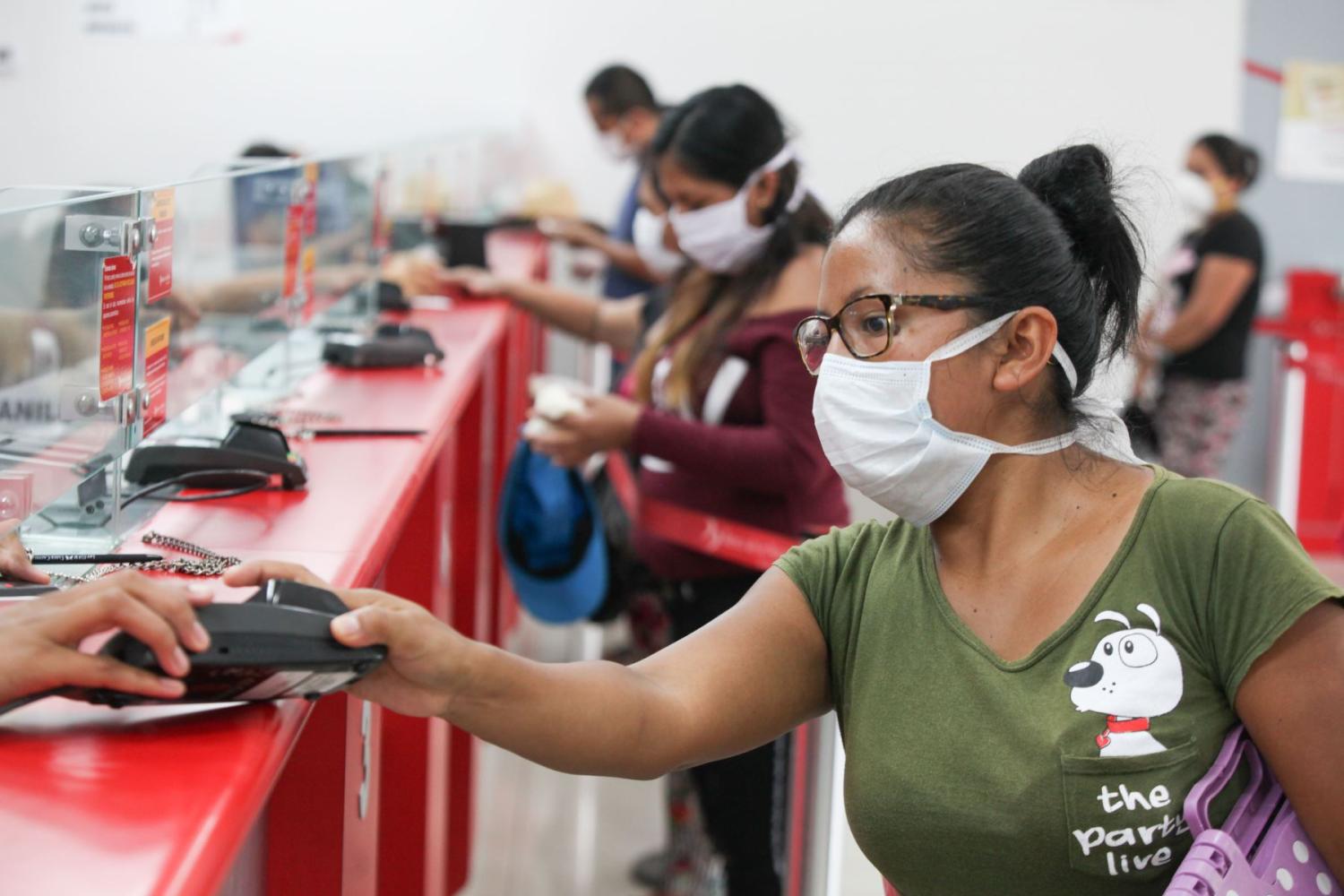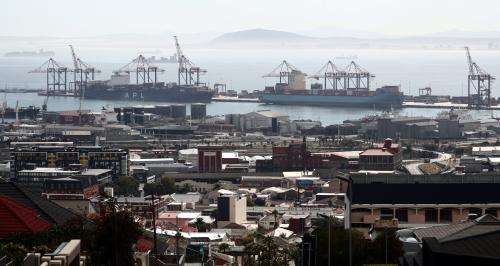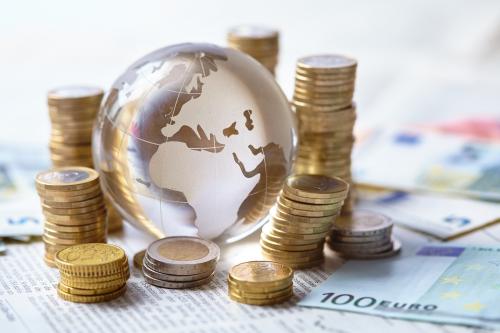Introduction
The economic outlook for developing countries is grim in the wake of COVID-19. Total output in developing countries, sans China, is projected to fall by 5.7 percent in 2020, with a recovery of 5 percent in 2021.1 Compared to pre-COVID projections, this amounts to an 8.1 percent loss by the end of 2021, worse than advanced countries at -4.7 percent.
The OECD estimates that developing countries will see a drop of $700 billion in private finance in 2020.2 Already, in the first five months of the crisis, developing countries experienced a portfolio outflow of negative $103 billion.3 While trade has started to rebound as lockdowns have lifted, foreign direct investment (FDI) flows to emerging and developing countries are still set to fall 30 to 45 percent in 2020.4 Trade financing has proven particularly vulnerable to shocks in the past, and estimates suggest that $1.9 trillion to $5 trillion will be needed to enable a V-shaped recovery.5 Remittances, a major source of investment for many developing countries, are also expected to fall by 7 percent this year, and another 7.5 percent in 2021.6
Real economy recession, coupled with a weakening of many currencies, will lead to a fall in nominal U.S. dollar GDP of developing countries (excluding China) of 10 percent in 2020. And although developing countries have been far more modest in fiscal support than has been the case in advanced economies, general government debt levels, including foreign exchange debt levels, have continued to rise in 2020, with prospects of further deterioration in 2021. Sovereign debt levels are forecast to rise by 12 percentage points of GDP in emerging markets and 8 percentage points in low-income countries.7
Only one sub-Saharan African country has been able to access the sovereign debt market since February.8 Thirty-six developing countries have been downgraded by one or more of the four largest credit rating agencies. There is every expectation that debt restructuring will loom large on the international policy agenda in 2021.
G-20 leaders, following a call from the African Ministers of Finance,9 have already agreed to a Debt Service Suspension Initiative (DSSI) for all International Development Association (IDA) countries and Angola to free up fiscal policy space for COVID-19 response efforts.10 The initiative initially covered all debt service due between May 1 and the end of 2020, and has since been extended to June 2021.11
So far, however, DSSI agreements have only covered $5 billion in debt service due. Doubtless this number will increase, but the agreement falls well short of what developing countries owe: $356 billion in debt service on public and publicly guaranteed debt due in 2021, and another $329 billion in 2022 (see Figure 1). Additional amounts of some $500 billion are also due on private non-guaranteed debt service, amounts that are not yet public liabilities but that, in past debt crises, have become socialized when foreign exchange availability has dried up. In other words, there are significant explicit public debt liabilities and the potential for additional implicit liabilities to arise.
Policymakers must decide what to do. The lessons from past debt episodes are that interventions that are too little, too late result in inefficiencies and significant social and financial costs linked with large-scale debt overhang problems and repeated restructurings.12 Conversely, too rapid and too large an intervention generates a moral hazard, potentially throws good money after bad, and can seriously affect future access of countries to capital markets.
This paper provides a framework and some evidence for how to arrive at a Goldilocks solution. Debt problems are highly country- and context-specific, so we do not attempt a formal analysis or recommendation for any particular country. But we believe that a sketch of the debt servicing landscape for 2021 and 2022 will improve understanding of the differentiated policy response that will be needed.
The main message is simple. Public debt servicing problems go far beyond the DSSI in terms of the number of affected countries. While some countries require proper debt workouts with equitable burden-sharing, the larger part of the problem is one of liquidity—the ability to roll over principal repayments at affordable rates. Organizing this, and at the same time providing a context for external financing of the investments needed to transform economies through sustainable development, is the great challenge in front of the international community.
-
Footnotes
- Gita Gopinath, “A Long, Uneven and Uncertain Ascent,” IMF Blog, October 13, 2020, https://blogs.imf.org/2020/10/13/a-long-uneven-and-uncertain-ascent/.
- OECD, Global Outlook on Financing for Sustainable Development (Paris: OECD, 2020), https://www.oecd-ilibrary.org/development/global-outlook-on-financing-for-sustainable-development-2021_e3c30a9a-en.
- “OECD Investment Policy Response to COVID-19,” OECD, last modified June 4, 2020, http://www.oecd.org/coronavirus/policy-responses/oecd-investment-policy-responses-to-covid-19-4be0254d/.
- UNCTAD, World Investment Report 2020 (New York: UN, 2020), https://unctad.org/system/files/official-document/wir2020_en.pdf.
- International Chamber of Commerce, “Trade Financing and COVID-19: Priming the market to drive a rapid economic recovery,” May, 2020, https://iccwbo.org/content/uploads/sites/3/2020/05/icc-trade-financing-covid19.pdf.
- KNOMAD, “Phase II: COVID-19 Crisis through a Migration Lens,” Migration and Development Brief, no. 33 (October 2020), https://www.knomad.org/sites/default/files/2020-10/Migration%20%26%20Development%20Brief%2033.pdf.
- Peter Breuer and Charles Cohen, “Time is Ripe for Innovation in the World of Sovereign Debt Restructuring,” IMF Blog, November 19, 2020, https://blogs.imf.org/2020/11/19/time-is-ripe-for-innovation-in-the-world-of-sovereign-debt-restructuring/?utm_medium=email&utm_source=govdelivery.
- Reuters, “UPDATE 1- Ivory Coast raises 1 billion euros in Eurobond sale,” November 25, 2020, https://www.reuters.com/article/ivorycoast-bonds/update-1-ivory-coast-raises-1-billion-euros-in-eurobond-sale-idUSL8N2IB4QA.
- UN Economic Commission for Africa, “Report on African Ministers of Finance Meeting: Emergency Request to the international Community on COVID-19 Response,” March 22, 2020, https://www.tralac.org/documents/resources/covid-19/3233-report-on-african-ministers-of-finance-meeting-emergency-request-to-the-international-community-on-covid-19-response-uneca-22-march-2020/file.html.
- G20, “Communique – G20 Finance Ministers and Central Bank Governors Meeting,” April 15, 2020, https://g20.org/en/media/Documents/G20_FMCBG_Communiqu%C3%A9_EN%20(2).pdf.
- Paris Club, “Communique – Extension of DSSI and Common Framework for Debt Treatment,” October 14, 2020, https://clubdeparis.org/en/communications/press-release/extension-of-dssi-and-common-framework-for-debt-treatments-14-10-2020.
- Martin Guzman, Jose Antonio Ocampo and Joseph E. Stiglitz, Too Little, Too Late: The Quest to Resolve Sovereign Debt Crises, (New York: Colombia University Press, 2016), http://cup.columbia.edu/book/too-little-too-late/9780231179263; Kevin Watkins, “Delivering Debt Relief for the Poorest,” IMF Finance & Development (Fall 2020), https://www.imf.org/external/pubs/ft/fandd/2020/08/debt-relief-for-the-poorest-kevin-watkins.htm.








